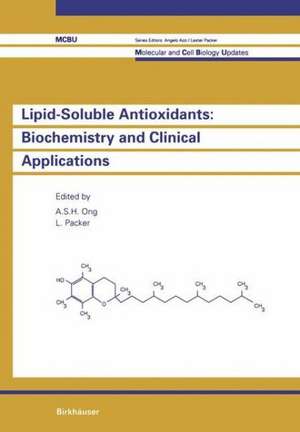Lipid-Soluble Antioxidants: Biochemistry and Clinical Applications: Molecular and Cell Biology Updates
Autor ONG, Packeren Limba Engleză Paperback – 26 noi 2012
Din seria Molecular and Cell Biology Updates
- 5%
 Preț: 375.34 lei
Preț: 375.34 lei - 15%
 Preț: 585.04 lei
Preț: 585.04 lei - 5%
 Preț: 653.87 lei
Preț: 653.87 lei - 15%
 Preț: 641.71 lei
Preț: 641.71 lei - 5%
 Preț: 369.84 lei
Preț: 369.84 lei - 15%
 Preț: 649.06 lei
Preț: 649.06 lei -
 Preț: 393.35 lei
Preț: 393.35 lei -
 Preț: 394.29 lei
Preț: 394.29 lei -
 Preț: 396.02 lei
Preț: 396.02 lei - 5%
 Preț: 368.37 lei
Preț: 368.37 lei -
 Preț: 392.21 lei
Preț: 392.21 lei - 5%
 Preț: 376.22 lei
Preț: 376.22 lei -
 Preț: 403.15 lei
Preț: 403.15 lei - 5%
 Preț: 1418.12 lei
Preț: 1418.12 lei -
 Preț: 407.01 lei
Preț: 407.01 lei -
 Preț: 400.65 lei
Preț: 400.65 lei - 15%
 Preț: 596.69 lei
Preț: 596.69 lei
Preț: 414.14 lei
Nou
Puncte Express: 621
Preț estimativ în valută:
79.25€ • 84.74$ • 66.07£
79.25€ • 84.74$ • 66.07£
Carte tipărită la comandă
Livrare economică 17 aprilie-01 mai
Preluare comenzi: 021 569.72.76
Specificații
ISBN-13: 9783034874342
ISBN-10: 3034874340
Pagini: 656
Ilustrații: XII, 642 p. 39 illus.
Greutate: 1.03 kg
Ediția:Softcover reprint of the original 1st ed. 1992
Editura: Birkhäuser Basel
Colecția Birkhäuser
Seria Molecular and Cell Biology Updates
Locul publicării:Basel, Switzerland
ISBN-10: 3034874340
Pagini: 656
Ilustrații: XII, 642 p. 39 illus.
Greutate: 1.03 kg
Ediția:Softcover reprint of the original 1st ed. 1992
Editura: Birkhäuser Basel
Colecția Birkhäuser
Seria Molecular and Cell Biology Updates
Locul publicării:Basel, Switzerland
Public țintă
ResearchCuprins
Vitamin E: Tocopherols and Tocotrienols and Ubiquinones.- New horizons in vitamin E research — The vitamin E cycle, biochemistry, and clinical applications.- The reactivity of tocotrienols and other lipid-soluble antioxidants towards peroxyl radicals.- Physical/chemical studies of vitamin E in membranes.- Synergistic effect of lipid hydroperoxyl radical scavenging and lipid hydroperoxide reduction in the inhibition of lipid peroxidation in biomembranes.- Determination of rate constants for antioxidant activity and use of the crocin assay.- Vitamin E in protection of oxidative impairment in endothelial and platelet functions.- Antioxidant effectiveness of tocopherol isomers.- Effect of vitamin E on metabolism of uremic low density lipoproteins in human monocyte-derived macrophage.- Difference of antioxidative effect between vitamin E and selenium.- Tocopherol and tocotrienol plasma transport and tissue concentrations: Implications for their relative biological functions.- Modulation of cell proliferation by tocopherols and tocotrienols: Role in arteriosclerosis.- Vitamin E and health in the marmoset monkey: A non-human primate model for nutritional research.- Antitumor and antioxidant activity of tocotrienols.- Tocopherols, carotenoids and the glutathione system.- Nutrition of tocotrienols and lipid metabolism.- Carotenoids, Flavonoids and Retinoids.- Carotenoids and vitamin A: An overview.- Metabolism of carotenoids by enzymes of oxygen metabolism.- Role of ?-carotene in disease prevention with special reference to cancer.- Anti-tumor and anti-tumor promoting activity of ?- and ?-carotene.- Production of palm oil carotenoid concentrate and its potential application in nutrition.- Carotenoids, novel polyene polyketones and new capsorubin isomers as efficientquenchers of singlet molecular oxygen.- Modification of alloxan diabetes in rats by vitamin A status.- Flavonoids in foods: Their significance for nutrition and health.- Studies on flavonoids and related compounds as antioxidants in food.- Autocoid-immunopharmacology of flavonoids.- Anticarcinogenicity of flavonoids as studied by inhibition of lipid peroxidation, microsomal degranulation and their interactions with benzo(a)pyrene metabolites.- Role of retinoids in modulating the molecular actions of environmental carcinogens.- Parasitic and Infectious Diseases.- Free radicals and antioxidants in malaria.- Oxygen free radicals in malaria.- The mechanism of antimalarial action of artemisinin (Qinghaosu).- Erythrocytic GSH level and stability in Plasmodium vivax malaria.- Plasma lipid peroxidation in P. falciparum malaria.- Presence, formation and function of ubiquinones Q6 and Q8 in filarial parasites.- Catalase activity in red cell and liver of mice infected with Plasmodium berghei.- Clinical Applications. Antioxidant Therapy.- The hypolipidaemic effect of different diets.- Epidemiological correlations between poor plasma levels of essential antioxidants and the risk of coronary heart disease and cancer.- Effect of different antioxidants in experimental myocardial infarction.- Lipid-soluble plant phenols as antioxidants and anti-mutagens.- Anti-cancer effects of cis-unsaturated fatty acids both in vitro and in vivo.- Clinical studies on polyunsaturated fatty acids and antioxidants in African children.- Dihydrolipoic acid is protective against reperfusion injury.- Effect of japanese herbal medicine, Sho-saiko-to-go-keishi-kashakuyaku-to (TJ-960) on aging.- Lipoprotein oxidation.- Hepatic lipid peroxidation in ethanol potentiated aflatoxin B1 hepatotoxicity.- Palm oil vitamin E effects in hypercholesterolemia.- Fat soluble antioxidant vitamins in cancer patients.- Butylated hydroxytoluene toxicity.- Effects of tocotrienols-rich vitamin E on patients with peripheral vascular disease.- Protection from air pollution injury by dietary vitamin E.
